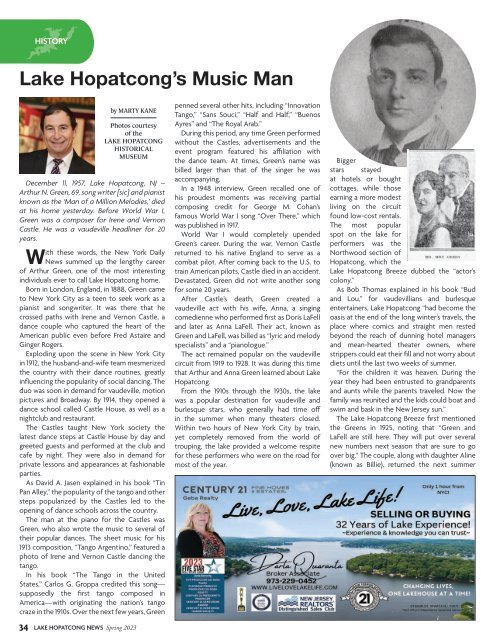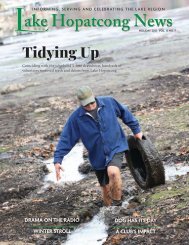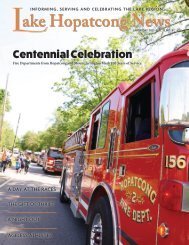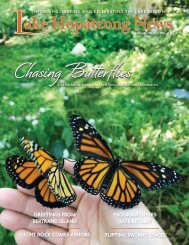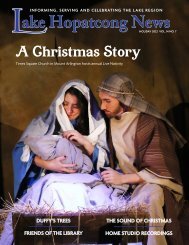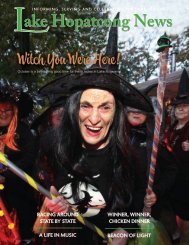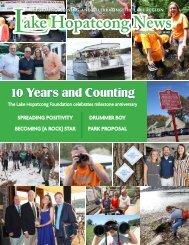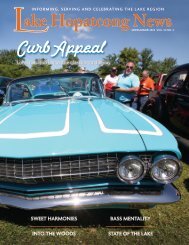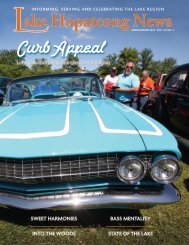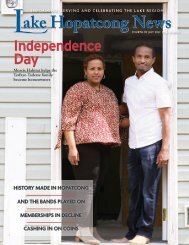Spring 2023 Issue
Create successful ePaper yourself
Turn your PDF publications into a flip-book with our unique Google optimized e-Paper software.
HISTORY<br />
Lake Hopatcong’s Music Man<br />
34<br />
by MARTY KANE<br />
Photos courtesy<br />
of the<br />
LAKE HOPATCONG<br />
HISTORICAL<br />
MUSEUM<br />
December 11, 1957, Lake Hopatcong, NJ –<br />
Arthur N. Green, 69, song writer [sic] and pianist<br />
known as the ‘Man of a Million Melodies,’ died<br />
at his home yesterday. Before World War I,<br />
Green was a composer for Irene and Vernon<br />
Castle. He was a vaudeville headliner for 20<br />
years.<br />
With these words, the New York Daily<br />
News summed up the lengthy career<br />
of Arthur Green, one of the most interesting<br />
individuals ever to call Lake Hopatcong home.<br />
Born in London, England, in 1888, Green came<br />
to New York City as a teen to seek work as a<br />
pianist and songwriter. It was there that he<br />
crossed paths with Irene and Vernon Castle, a<br />
dance couple who captured the heart of the<br />
American public even before Fred Astaire and<br />
Ginger Rogers.<br />
Exploding upon the scene in New York City<br />
in 1912, the husband-and-wife team mesmerized<br />
the country with their dance routines, greatly<br />
influencing the popularity of social dancing. The<br />
duo was soon in demand for vaudeville, motion<br />
pictures and Broadway. By 1914, they opened a<br />
dance school called Castle House, as well as a<br />
nightclub and restaurant.<br />
The Castles taught New York society the<br />
latest dance steps at Castle House by day and<br />
greeted guests and performed at the club and<br />
cafe by night. They were also in demand for<br />
private lessons and appearances at fashionable<br />
parties.<br />
As David A. Jasen explained in his book “Tin<br />
Pan Alley,” the popularity of the tango and other<br />
steps popularized by the Castles led to the<br />
opening of dance schools across the country.<br />
The man at the piano for the Castles was<br />
Green, who also wrote the music to several of<br />
their popular dances. The sheet music for his<br />
1913 composition, “Tango Argentino,” featured a<br />
photo of Irene and Vernon Castle dancing the<br />
tango.<br />
In his book “The Tango in the United<br />
States,” Carlos G. Groppa credited this song—<br />
supposedly the first tango composed in<br />
America—with originating the nation’s tango<br />
craze in the 1910s. Over the next few years, Green<br />
LAKE HOPATCONG NEWS <strong>Spring</strong> <strong>2023</strong><br />
penned several other hits, including “Innovation<br />
Tango,” “Sans Souci,” “Half and Half,” “Buenos<br />
Ayres” and “The Royal Arab.”<br />
During this period, any time Green performed<br />
without the Castles, advertisements and the<br />
event program featured his affiliation with<br />
the dance team. At times, Green’s name was<br />
billed larger than that of the singer he was<br />
accompanying.<br />
In a 1948 interview, Green recalled one of<br />
his proudest moments was receiving partial<br />
composing credit for George M. Cohan’s<br />
famous World War I song “Over There,” which<br />
was published in 1917.<br />
World War I would completely upended<br />
Green’s career. During the war, Vernon Castle<br />
returned to his native England to serve as a<br />
combat pilot. After coming back to the U.S. to<br />
train American pilots, Castle died in an accident.<br />
Devastated, Green did not write another song<br />
for some 20 years.<br />
After Castle’s death, Green created a<br />
vaudeville act with his wife, Anna, a singing<br />
comedienne who performed first as Doris LaFell<br />
and later as Anna LaFell. Their act, known as<br />
Green and LaFell, was billed as “lyric and melody<br />
specialists” and a “pianologue.”<br />
The act remained popular on the vaudeville<br />
circuit from 1919 to 1928. It was during this time<br />
that Arthur and Anna Green learned about Lake<br />
Hopatcong.<br />
From the 1910s through the 1930s, the lake<br />
was a popular destination for vaudeville and<br />
burlesque stars, who generally had time off<br />
in the summer when many theaters closed.<br />
Within two hours of New York City by train,<br />
yet completely removed from the world of<br />
trouping, the lake provided a welcome respite<br />
for these performers who were on the road for<br />
most of the year.<br />
Bigger<br />
stars stayed<br />
at hotels or bought<br />
cottages, while those<br />
earning a more modest<br />
living on the circuit<br />
found low-cost rentals.<br />
The most popular<br />
spot on the lake for<br />
performers was the<br />
Northwood section of<br />
Hopatcong, which the<br />
Lake Hopatcong Breeze dubbed the “actor’s<br />
colony.”<br />
As Bob Thomas explained in his book “Bud<br />
and Lou,” for vaudevillians and burlesque<br />
entertainers, Lake Hopatcong “had become the<br />
oasis at the end of the long winter’s travels, the<br />
place where comics and straight men rested<br />
beyond the reach of dunning hotel managers<br />
and mean-hearted theater owners, where<br />
strippers could eat their fill and not worry about<br />
diets until the last two weeks of summer.<br />
“For the children it was heaven. During the<br />
year they had been entrusted to grandparents<br />
and aunts while the parents traveled. Now the<br />
family was reunited and the kids could boat and<br />
swim and bask in the New Jersey sun.”<br />
The Lake Hopatcong Breeze first mentioned<br />
the Greens in 1925, noting that “Green and<br />
LaFell are still here. They will put over several<br />
new numbers next season that are sure to go<br />
over big.” The couple, along with daughter Aline<br />
(known as Billie), returned the next summer


